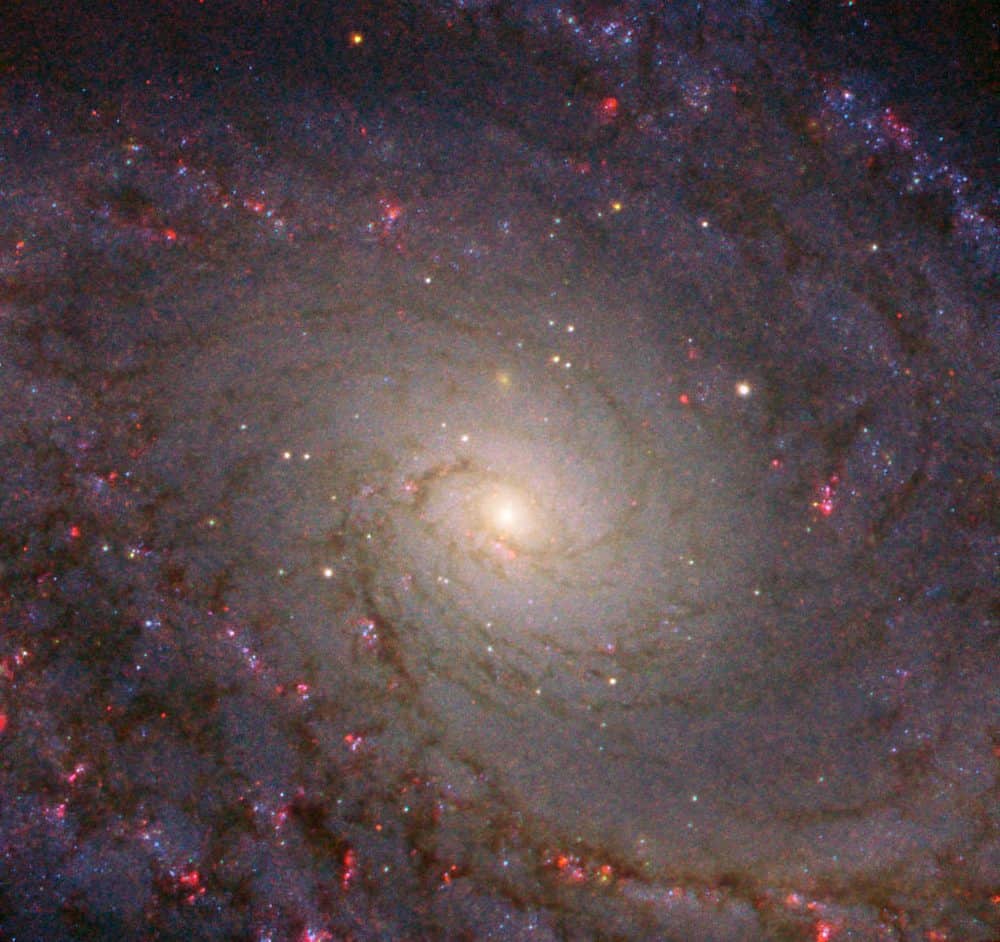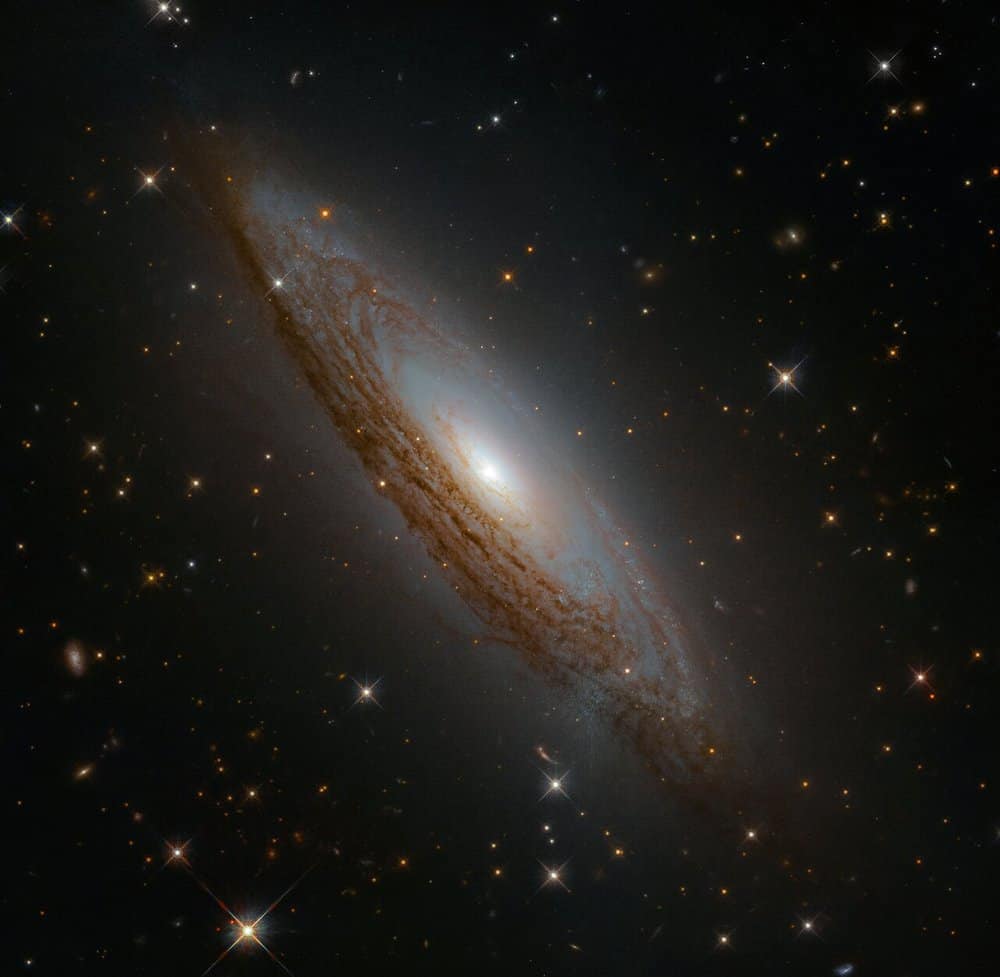Blog
This eye-catching galaxy is known as NGC 5364. The late-type normal spiral galaxy NGC 5364 is located at a distance of 57 million light-years.
Unmistakably a spiral, NGC 5364 is also something known as a grand design spiral galaxy — a descriptive name deserved by only one-tenth of spirals. While all spirals have a structure that is broadly similar, there is quite a bit of variation amongst individual galaxies; some have patchy, oddly-shaped arms, some have bars of stars cutting through their core, some are colossal and radiant, and others are dim and diminutive. Grand designs like NGC 5364 are in many ways the archetype of a spiral galaxy. They are characterized by their prominent, well-defined arms, which circle outwards from a clear core.
Despite being classified in this way, NGC 5364 is far from perfect. Its arms are asymmetrical compared to other grand design spirals — this is thought to be due to interactions with a nearby neighbor. This neighbor and NGC 5364 are tugging on one another, warping and moving their stars and gas around and causing this misshapen appearance.

Natalie Maria Cole (February 6, 1950 – December 31, 2015) was an American singer, songwriter, and actress. Cole was the daughter of American singer and jazz pianist Nat King Cole. She rose to success in the mid-1970s as an R&B singer with the hits “This Will Be“, “Inseparable” (1975), and “Our Love” (1977). She returned as a pop singer on the 1987 album Everlasting and her cover of Bruce Springsteen‘s “Pink Cadillac“. In the 1990s, she sang traditional pop by her father, resulting in her biggest success, Unforgettable… with Love, which sold over seven million copies and won her seven Grammy Awards. She sold over 30 million records worldwide. On December 31, 2015, Cole died at the age of 65 at Cedars-Sinai Medical Center in Los Angeles, California, due to congestive heart failure.
Natalie Cole was born at Cedars of Lebanon Hospital in Los Angeles, to American singer and jazz pianist Nat King Cole and former Duke EllingtonOrchestra singer Maria Hawkins Ellington, and raised in the affluent Hancock Park district of Los Angeles. Regarding her childhood, Cole referred to her family as “the black Kennedys” and was exposed to many great singers of jazz, soul and blues. At the age of 6, Natalie sang on her father’s Christmas album The Magic of Christmas and later started performing at age 11.
more...Robert Nesta Marley, OM (6 February 1945 – 11 May 1981) was a Jamaican singer and songwriter. Considered one of the pioneers of reggae, his musical career was marked by blending elements of reggae, ska, and rocksteady, as well as forging a smooth and distinctive vocal and songwriting style. Marley’s contributions to music increased the visibility of Jamaican music worldwide, and made him a global figure in popular culture for over a decade. Over the course of his career Marley became known as a Rastafari icon, and the singer sought to infuse his music with a sense of spirituality. He is also considered a global symbol of Jamaican culture and identity, and was controversial in his outspoken support for the legalization of marijuana, while he also advocated for Pan-Africanism.
Born in Nine Mile, British Jamaica, Marley began his professional musical career in 1963, after forming Bob Marley and the Wailers. The group released its debut studio album The Wailing Wailers in 1965, which contained the single “One Love/People Get Ready“; the song was immensely popular, peaking in the top five on worldwide music charts, and established the group as a rising figure in reggae. The Wailers subsequently released eleven further studio albums; while initially employing louder instrumentation and singing, the group began engaging in rhythmic-based song construction in the late 1960s and early 1970s, which coincided with the singer’s conversion to Rastafarianism. During this period Marley relocated to London, and the group typified their musical shift with the release of the album The Best of The Wailers (1971).
The group attained international success after the release of the albums Catch a Fire and Burnin’ (both 1973), and forged a reputation as touring artists. A year later the Wailers disbanded, and Marley went on to release his solo material under the band’s name.[10] His debut studio album Natty Dread (1974) received positive reception, as did its follow-up Rastaman Vibration (1976). A few months after the album’s release Marley survived an assassination attempt at his home in Jamaica, which prompted him to permanently relocate to London soon afterward. There he recorded the album Exodus (1977); it incorporated elements of blues, soul, and British rock, enjoyed widespread commercial success, and is widely considered one of the best albums of all time.
In 1977, Marley was diagnosed with acral lentiginous melanoma; he died as a result of the illness in 1981. His fans around the world expressed their grief, and he received a state funeral in Jamaica. The greatest hits album Legend was released in 1984, and subsequently became the best-selling reggae album of all-time. Marley also ranks as one of the best-selling music artists of all-time, with estimated sales of more than 75 million records worldwide, while his sound and style have influenced artists of various genres. He was posthumously honored by Jamaica soon after his death, as he was designated the nation’s Order of Merit award.
https://www.youtube.com/watch?v=imfiY8ZVZ0g
more...John Pisano (born February 6, 1931) is a jazz guitarist born in Staten Island, New York.
Pisano has worked with Herb Alpert, Billy Bean, Chico Hamilton, Peggy Lee, and Joe Pass.
more...An international team of astronomers led by scientists at the University of California, Riverside, has found an unusual monster galaxy that existed about 12 billion years ago, when the universe was only 1.8 billion years old.
Dubbed XMM-2599, the galaxy formed stars at a high rate and then died. Why it suddenly stopped forming stars is unclear.
“Even before the universe was 2 billion years old, XMM-2599 had already formed a mass of more than 300 billion suns, making it an ultramassive galaxy,” said Benjamin Forrest, a postdoctoral researcher in the UC Riverside Department of Physics and Astronomy and the study’s lead author. “More remarkably, we show that XMM-2599 formed most of its stars in a huge frenzy when the universe was less than 1 billion years old, and then became inactive by the time the universe was only 1.8 billion years old.”
The team used spectroscopic observations from the W. M. Keck Observatory’s powerful Multi-Object Spectrograph for Infrared Exploration, or MOSFIRE, to make detailed measurements of XMM-2599 and precisely quantify its distance.

Al Kooper (born Alan Peter Kuperschmidt, February 5, 1944) is an American songwriter, record producer and musician, known for organizing Blood, Sweat & Tears, although he did not stay with the group long enough to share its popularity. Throughout much of the 1960s and 1970s, he was a prolific studio musician, playing organ on the Bob Dylan song “Like A Rolling Stone“, French horn on the Rolling Stones song “You Can’t Always Get What You Want“, and lead guitar on Rita Coolidge‘s “The Lady’s Not for Sale“, among many other appearances. He also produced a number of one-off collaboration albums, such as the Super Session album that brought together guitarists Mike Bloomfield and Stephen Stills. In the 1970s he was a successful manager and producer, notably recording Lynyrd Skynyrd‘s first three albums. He has also had a successful solo career, written music for film soundtracks, and has lectured in musical composition. He continues to perform live.
Kooper, born in Brooklyn, to Sam and Natalie Kooper and grew up in a Jewish family in Hollis Hills, Queens, New York.
more...Richard Quentin Laird (born 5 February 1941) is an Irish bassist who is best known for his place in the American jazz fusion band Mahavishnu Orchestra.
Born in Dublin, Ireland, Laird played music from a young age and enrolled for guitar and piano lessons. He started playing jazz after moving to New Zealand at the age of 16 with his father. He played guitar in jam bands in New Zealand before buying an upright bass. After extensive touring in New Zealand he moved to Sydney, Australia, where he played with many top jazz musicians including Don Burrows.
He moved to England in 1962 and became house bassist at Ronnie Scott’s Jazz Club in London, playing with many greats including the guitarist Wes Montgomery and Sonny Stitt and even with Buddy Rich, most notably the residence at The Talk of the Town in 1969. From 1963 to 1964 Laird was at London’s Guildhall School of Music and Drama. He was recorded on Sonny Rollins‘s record Alfie and played in The Brian Auger Trinity (July 1963-February 1964) and The Brian Auger Group (February–October 1964).
His next step was to go to Berklee College of Music in Boston, US, where he studied arranging, composition and string bass. He then teamed up with John McLaughlin and The Mahavishnu Orchestra to play electric bass until 1973, when the band broke up. After that, he moved to New York and played with Stan Getz (a tour in 1977) and Chick Corea (a tour the following year). Laird put out one album as a leader, Soft Focus. He was interviewed in Guitar Player in 1980 and Bass Player in 1999. Today, he is a successful photographer as well as a private bass tutor and an author of a number of intermediate- to advanced-level bass books.
more...Big Bill Bissonnette (February 5, 1937 – June 26, 2018) was an American jazz trombonist, drummer, and record producer.
He was a strong advocate of New Orleans jazz as played by veteran African-American musicians. In the 1960s, he led his own group, the Easy Riders Jazz Band, formed his own label, Jazz Crusade, and organized northern tours for Kid Thomas Valentine, George Lewis, and Jim Robinson. He produced over 100 recorded jazz sessions for Jazz Crusade and appeared as trombonist or drummer on over 50 recording sessions of New Orleans jazz.[citation needed]
The Easy Riders Jazz Band was one of the most acclaimed revival bands of the 1960s. Bissonnette brought Sammy Rimington to the United States. During his career, he worked with Alvin Alcorn, Red Allen, Jimmy Archey, Polo Barnes, Albert Burbank, Alex Bigard, Don Ewell, Pops Foster, George Guesnon, Edmond Hall, Bob Helm, Tuba Fats Lacen, George Lewis, Fred Lonzo, Alcide Pavageau, George Probert, Kid Sheik, Zutty Singleton, Victoria Spivey, Gregg Stafford, Michael White, and Kid Thomas Valentine.
more...Seeing mountain peaks glow red from inside the Grand Canyon was one of the most incredible sunset experiences of this amateur photographer’s life. They appeared even more incredible later, when digitally combined with an exposure of the night sky — taken by the same camera and from the same location — an hour later. The two images were taken last August from the 220 Mile Canyon campsite on the Colorado River, Colorado, USA. The peaks glow red because they were lit by an usually red sunset. Later, high above, the band of the Milky Way Galaxy angled dramatically down, filled with stars, nebula, and dark clouds of dust. To the Milky Way’s left is the planet Saturn, while to the right is the brighter Jupiter. Although Jupiter and Saturn are now hard to see, Venus will be visible and quite bright to the west in clear skies, just after sunset, for the next two months.

Clyde Austin Stubblefield (April 18, 1943 – February 18, 2017) was an American drummer best known for his work with James Brown. A self-taught musician, he was influenced by the sound of natural rhythms around him. His drum patterns on Brown’s recordings are considered funk standards. He recorded and toured with Brown for six years and settled in Madison, Wisconsin, where he was a staple of the local music scene. Often uncredited, samples of his drum patterns were heavily used in hip hop music. He was the recipient of an honorary doctorate in fine arts.
Born to Frank D. and Vena Stubblefield on April 18, 1943, he grew up in Chattanooga, Tennessee. He was inspired to pursue drumming after seeing drummers for the first time in a parade. As a youngster his sense of rhythm was influenced by the industrial sounds of factories and trains around him. He practiced the rhythm patterns he heard, sometimes playing two patterns simultaneously. Years later he said if he could hum a drum pattern, he could play it. He played professionally as a teenager and performed in local bands such as Blue Shufflers, Inclines, and Cascades. In early 1960s he moved to Macon, Georgia, and worked with guitarist Eddie Kirkland and toured with Otis Redding.
https://www.youtube.com/watch?v=8vDXrN-90p0
more...February 4th 1938. Born and raised in Ashland, MS, guitarist Joe Beard grew up with the Murphy brothers, one of whom later found an international following as Matt “Guitar” Murphy. Beard moved to Rochester, NY, and from time to time would visit one of his brothers in Chicago. He quickly became enamored of the blues being played in clubs there by people like Jimmy Reed and Sonny Boy Williamson. Beard sat in with John Lee Hooker one night and received encouraging words from Hooker.
Beard befriended classic blues guitarist Son House, who was a neighbor in Rochester.. Beard worked as an electrician by day and would occasionally play out at night and on weekends for most of the ’60s on through to the ’80s. At Rochester’s famed BK Lounge, Beard and his backing bands opened for Bobby Bland, Albert King, and others.
Joe has played many major festivals in the US and Europe and was inducted to the Rochester Music Hall Of Fame in 2017. He has released 4 albums to great critical acclaim. One album featured Ronnie Earl and two others featured Duke Robillard.
more...
Jutta Hipp (February 4, 1925 – April 7, 2003) was a jazz pianist and composer. Born in Leipzig in the Weimar Republic, she initially listened to jazz in secret, as it was not approved of by the Nazi authorities. After surviving World War II, she became a refugee, often lacking food and other necessities. By the early 1950s, she was a touring pianist and soon led her own bands. Critic Leonard Feather heard Hipp perform in Germany in 1954, recorded her, and organized her move to the United States the following year. Club and festival appearances soon followed, as did album releases.
For reasons that are unclear, Hipp’s last recording was in 1956; she started working in a clothing factory, and ultimately cut herself off from the music world. She remained in the United States, and worked for the clothing company for 35 years. Hipp was born on February 4, 1925 in Leipzig in the Weimar Republic. Her family was middle class, with a Protestant background.
https://www.youtube.com/watch?v=KYKaF1KsEzo
https://www.youtube.com/watch?v=83JRa29A7qM
more...This swirling mass of celestial gas, dust, and stars is a moderately luminous spiral galaxy named ESO 021-G004, located just under 130 million light-years away.
This galaxy has something known as an active galactic nucleus. While this phrase sounds complex, this simply means that astronomers measure a lot of radiation at all wavelengths coming from the centre of the galaxy. This radiation is generated by material falling inwards into the very central region of ESO 021-G004, and meeting the behemoth lurking there — a supermassive black hole. As material falls towards this black hole it is dragged into orbit as part of an accretion disc; it becomes superheated as it swirls around and around, emitting characteristic high-energy radiation until it is eventually devoured.
The data comprising this image were gathered by the Wide Field Camera 3 aboard the NASA/ESA Hubble Space Telescope.

More Posts
- Jack Cassidy
- Bud Freeman
- World Music Kathryn Tickell
- Daily Roots Leroy Brown
- Temple Israel Erev Shabbat Service
- Cosmos Gum 41
- Herbie Hancock
- Shakey Jake Harris
- Flamenco Fridays Demarco Flamenco
- Daily Roots Johnny Osbourne
- Cosmos Eclipse Passage
- Will Wampach
- Neville Staple
- Frank Vicari
- John Lee Granderson
- World Music Jembaa Groove
- Daily Roots Groundation
- Echoes of Freedom Carl Jung
- Cosmos IC 4633